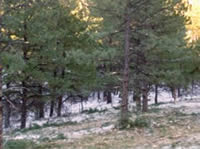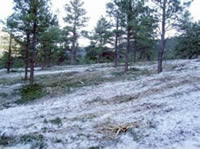
National Fire Plan Success Story
Hazardous Fuel Treatments and their Effects on the Mason Gulch Fire
San Isabel National Forest, San Carlos Ranger District, Colorado
National Fire Plan - Fuels Reduction
A series of hazardous fuels treatments conducted between 2000 and 2005 assisted suppression of the 2005 Mason Gulch Fire in Colorado. The treatments resulted from successful partnerships between the Pike and San Isabel National Forest, BLM Royal Gorge Field Office, Colorado State Forest Service, Rocky Mountain Elk Foundation, Sangre De Cristo Habitat Partnership Program, Colorado Division of Wildlife and the Rocky Mountain Bighorn Society. These treatments saved human life, critical infrastructure, wildlife habitat and critical watersheds.
The treatments implemented on the San Carlos Ranger District are classified as Wildland Urban Interface (WUI) projects on the southern end of the Colorado Front Range. Treatments consisted of a combination of prescribed burning and mastication. Approximately 5,000 acres were treated.

Mason Hydro-axe treatment area before treatment.

Mason Hydro-axe treatment area after treatment.
Lightning started the Mason Gulch fire on July 7, 2005. Multiple accounts of changing fire behavior as a result of prior fuels treatments were reported during the Mason Gulch Fire. Existing fuel breaks prevented the fire from spreading into the community of Greenwood and the Vaughn and Savage subdivisions. Further, treatment areas served as escape routes and safety zones for firefighters while working on the fireline.
Numerous residences and communities were evacuated during the Mason Gulch fire, including the communities of Greenwood and Beulah, Vaughn and Savage subdivisions, Red Creek Estates, all residents along Siloam Road and North Creek Road; as well as Hamilton Ranch, Everhart Ranch, and Bears Head Ranch. An estimated 2,000 families were evacuated over a ten day period. However, these fuel reduction projects around the fire perimeter prevented the loss of any primary residences.
Contact: Paul Langowski, 303-275-5307, plangowski@fs.fed.us